The automotive industry is facing a stark reality: nearly 40,000 lives are lost annually in the United States in automobile-related crashes, with another one million suffering severe, life-changing injuries.
Globally, the toll rises to 1.4 million fatalities, and tens of millions are severely injured each year. Despite decades of progress that halved deaths per million miles driven, the last decade has seen an alarming 30% increase in U.S. road deaths. This is not merely a statistical challenge; it is an urgent crisis demanding immediate, decisive action.
True progress—whether in improving efficiency, mitigating risk, or saving lives—is not achieved in isolation. It necessitates a fundamental shift in how we approach product development, leveraging cutting-edge technological advancements, forging collaborative partnerships across the industry, and integrating processes to an unprecedented degree.
A Mission is not theoretical. It is operational, measurable, and capable of transforming the outcomes we want to avoid.
Safety as a Mission: Five Priorities
The Safety as a Mission series delivers a critical message: the future of automotive safety is no longer incremental. It is strategic, system-wide, and urgent. What once passed as adequate is now a liability. As road fatalities rise and digital transformation accelerates, companies that treat safety as a core mission will lead. Those that delay will fall behind.

Our five takeaways are not talking points—they are executive priorities, primed for action. They define where innovation must go, how collaboration must function, and why integration must be built into every layer of product development. Most importantly, they are a direct call to leadership: lead the charge or become the problem.
- Road Safety is an Urgent Crisis Demanding Immediate Action:
With 40,000 annual U.S. road fatalities and a 30% increase in the last decade, the current trajectory is unsustainable and demands a revolutionary commitment to "Safety as a Mission".
- Technological Advancement is the Foundation of Future Safety:
Embracing next-generation ATDs, Human Body Models, AI-driven simulations, Connected Lab solutions, and Digital Proving Grounds is critical for accelerating product development, reducing costs, and achieving breakthroughs in both occupant and pedestrian safety.
- Collaborative Partnerships are Non-Negotiable for Innovation:
No single entity can solve today's complex safety challenges alone. Forming agile partnerships based on trust and flexibility with industry leaders, researchers, and regulatory bodies is essential for shared growth, risk distribution, and accelerated innovation. The Euro NCAP model serves as a prime example of successful, consensus-driven collaboration.
- Integrated Processes Drive Unprecedented Efficiency and Performance:
Unifying data across physical and virtual testing environments, streamlining lab operations, and adopting a system-of-systems approach are paramount for reducing development costs, shortening time to market, and ensuring that products work cohesively for optimal performance and user convenience.
- The Future of Safety is Integrated and Agile:
To lead in this fast-moving world, organizations must embrace the Agile Partnership Model as a core strategy, transforming integration from a concept into actionable, collaborative efforts that deliver safer, smarter products and set new standards for what is possible.
A QUICK RECAP OF THE SERIES
THE UNSTOPPABLE WAVE OF TECHNOLOGICAL ADVANCEMENT
The sixth wave of innovation is a period characterized by digital, clean, and human-centered technologies, including automation, artificial intelligence (AI), sustainability initiatives, and the Internet of Things (IoT). This era demands that engineering groups, traditionally accustomed to generational changes, adopt agile product development processes capable of accommodating multiple changes within a single year.
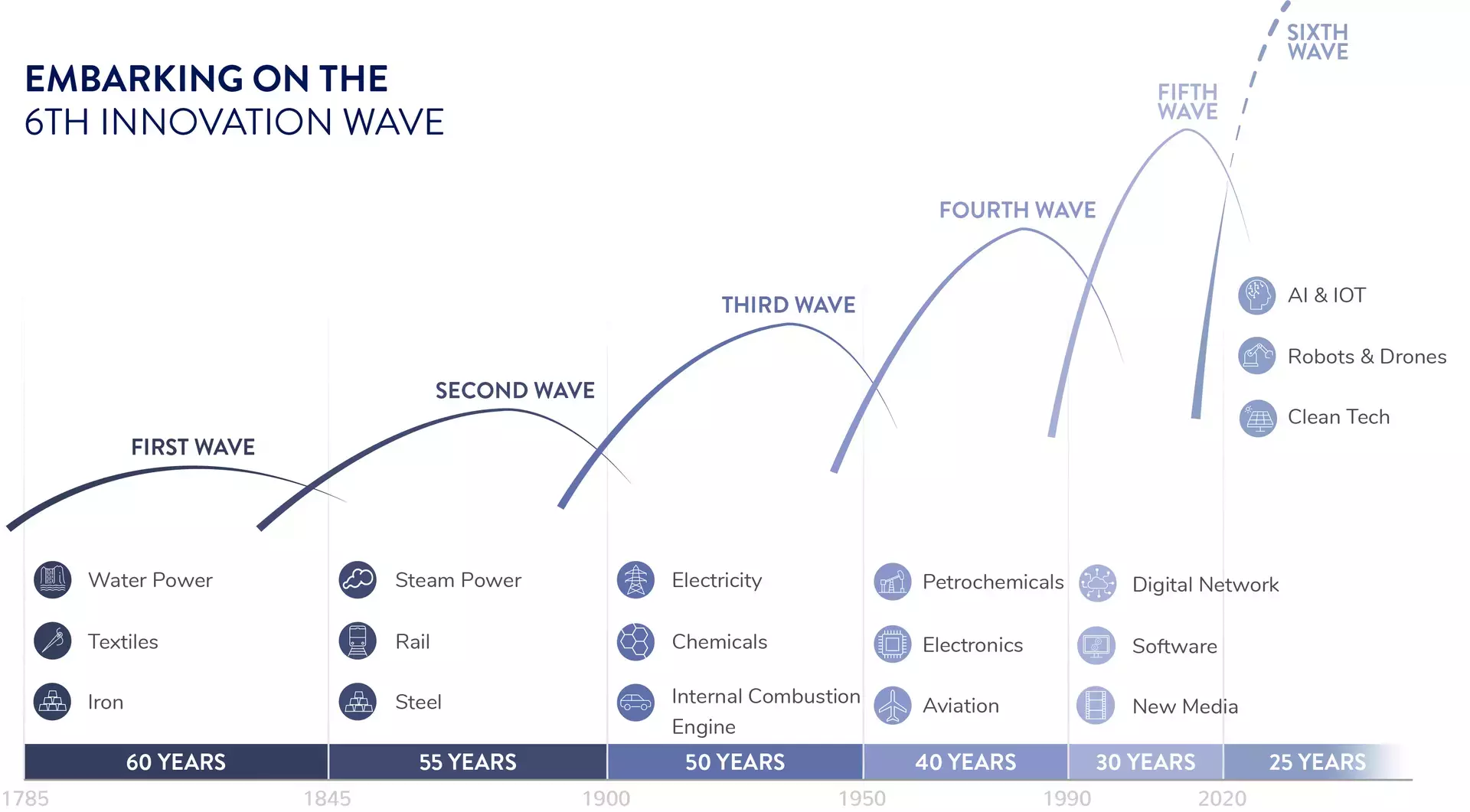
The ability to innovate at the speed of data is now paramount. This is powered by real-time data sharing, predictive analytics, and the rapid integration of new safety technologies, which dramatically shorten development cycles and enable dynamic responses to emerging risks.

Four Aspects of Passive and Active Safety Technologies that can Reduce Fatalities and Injuries
1. Next Generation Anthropomorphic Test Devices (ATDs) and Digital Twins
The Hybrid III "crash test dummy," introduced in 1976, no longer meets the complex demands of modern vehicle safety. Advanced ATDs like the THOR and WorldSID series accurately simulate human anatomy and injury responses, accommodating far more injury sensors than their predecessors.
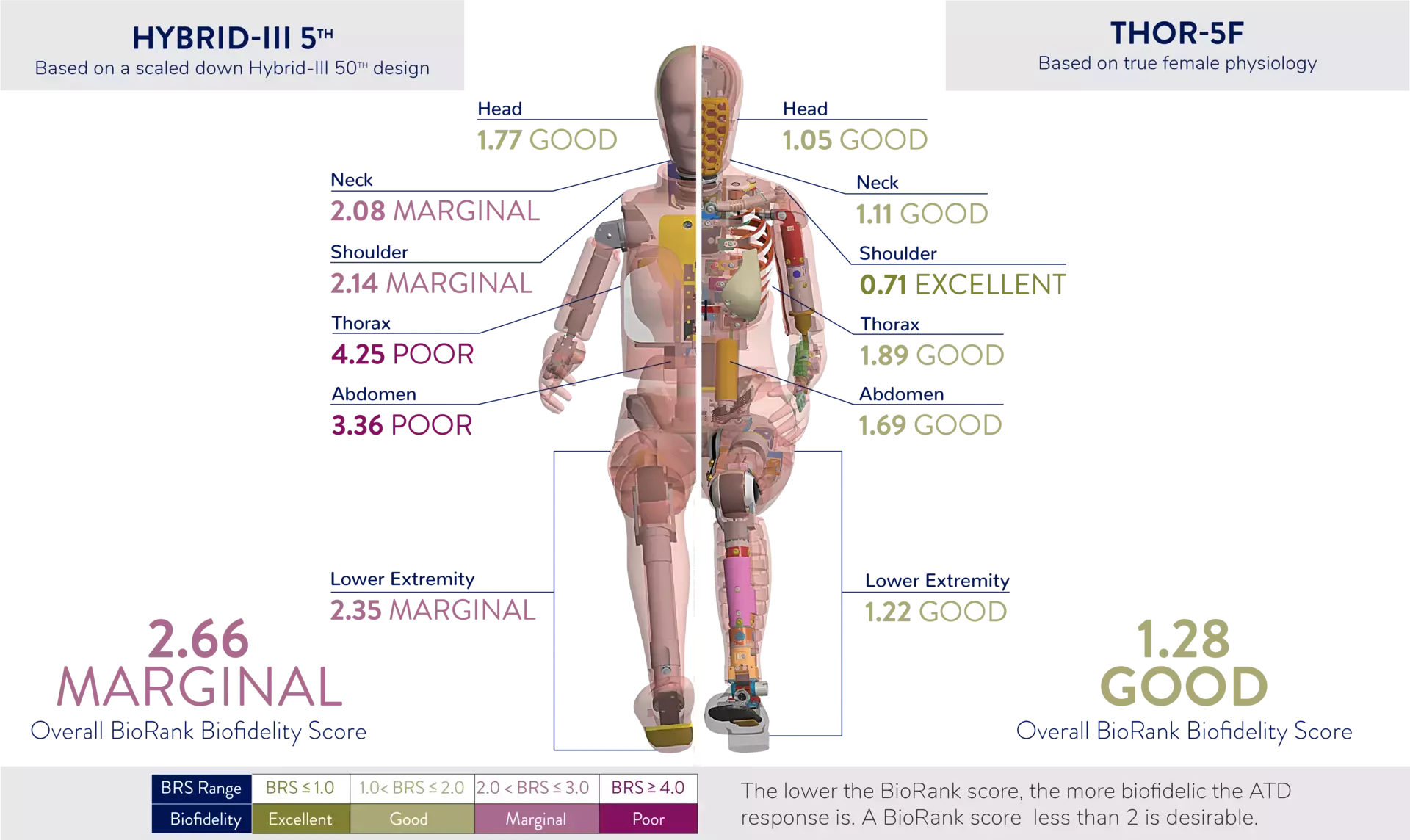
The THOR-5F, for instance, can utilize up to 174 channels, compared to the Hybrid III 5th's 63, and features an anatomically correct female pelvis and spine, addressing historical biases in vehicle safety testing. Integrating these physical ATDs with virtual anthropomorphic test devices (vATDs) facilitates the creation of "real-time digital twins," bridging physical testing and computer-aided engineering (CAE) simulations. This not only reduces vehicle development time and costs significantly but also enhances our ability to address complex vehicle designs and emerging technologies, such as those found in autonomous vehicles.
2. Human Body Models (HBMs)
These sophisticated models represent a monumental leap in understanding biomechanics and predicting injury across diverse populations, allowing designers to account for variations in age, gender, and body size far more effectively.
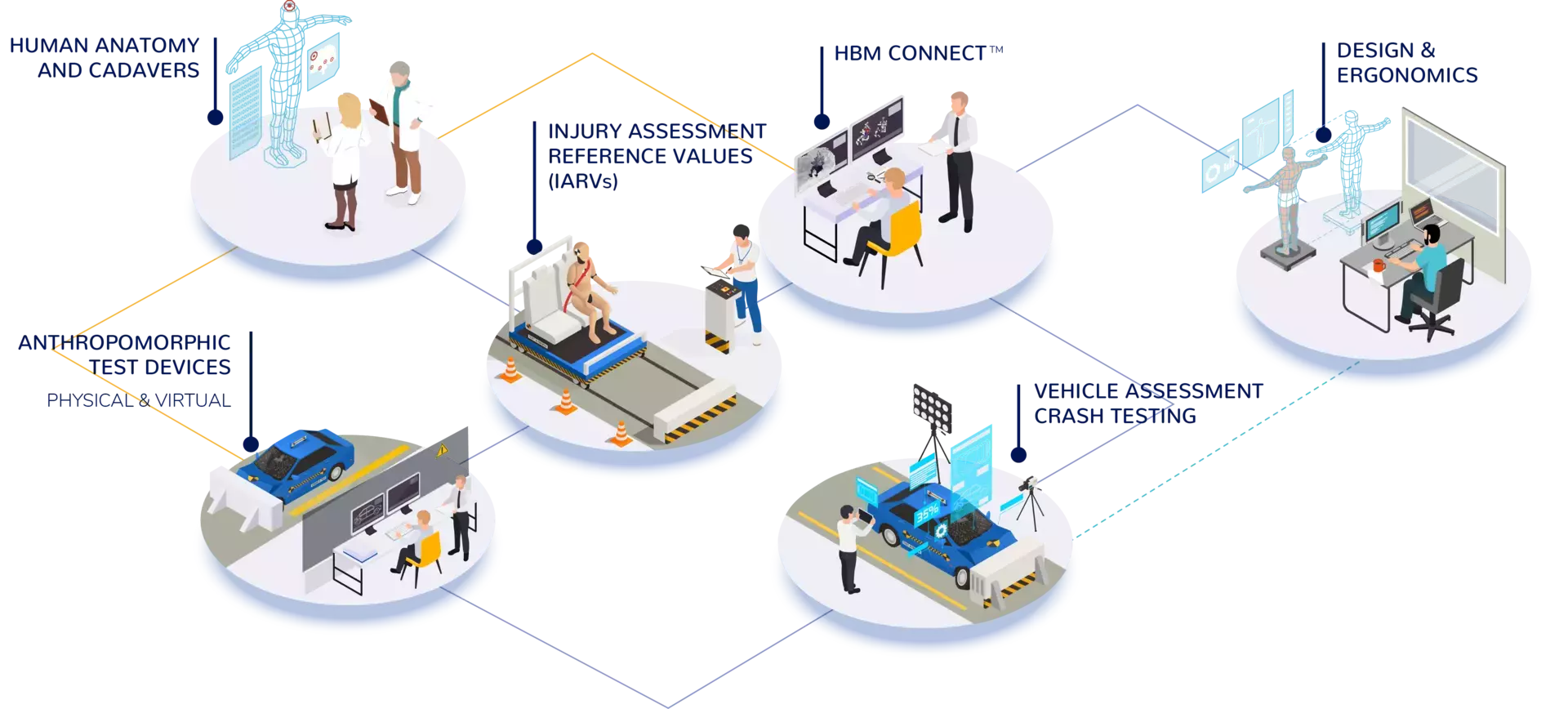
HBMs enable strain-based injury prediction, simulate pre-crash and low-G events, and are increasingly recognized by regulatory bodies for their cost and time efficiencies in development.
3. Connected Lab
The full potential of these advanced ATDs is unlocked when integrated with intelligent testing and management systems. Connected Lab solutions streamline laboratory operations, reduce downtime, and enhance test result consistency through centralized data acquisition and management, ensuring optimal performance and calibration of ATD fleets.
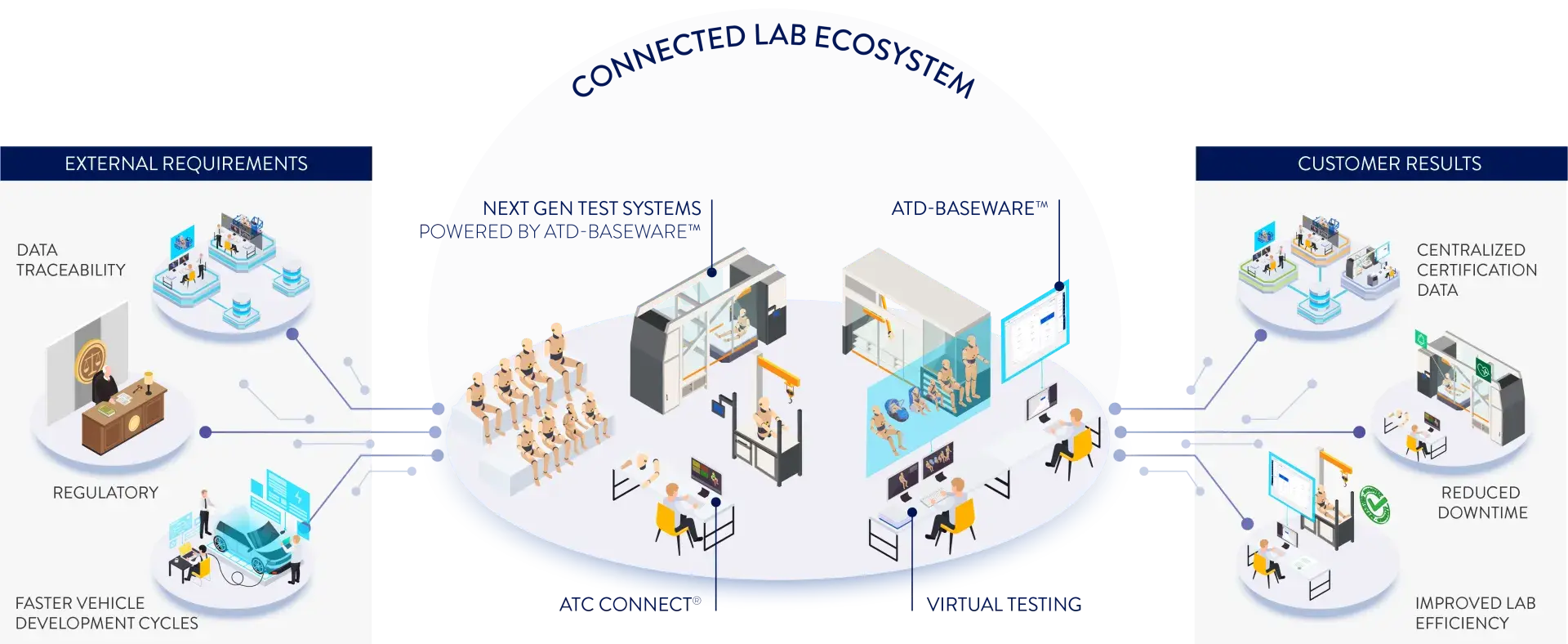
4. Digital Proving Grounds
Beyond the lab, the Digital Proving Ground is revolutionizing self-driving vehicle testing by combining advanced simulation with real-world environments. Solutions like TrackBase Connect® optimize active safety testing by managing scenarios, resources, and data, offering comprehensive visual representations that bridge virtual and physical environments.
This allows for the simulation of scenarios that would be dangerous or impossible to recreate physically, accelerating development timelines and enabling thousands of tests in virtual environments before physical prototypes are even built.
These four technologies are not merely incremental improvements; they represent a fundamental shift, moving us from reactive safety measures to proactive crash prevention.
INTEGRATING PROCESSES FOR UNPRECEDENTED PRODUCT DEVELOPMENT
The ultimate competitive advantage lies in the seamless integration of these technological advancements and collaborative partnerships into every facet of product development. An integrated ecosystem offers numerous advantages beyond just product synergy; it creates a cohesive environment that enhances efficiency, performance, and user convenience across various sectors.
The critical factors for success hinge on integrating new life-saving technologies into tool portfolios, reducing development costs to reinvest in innovation, and, crucially, unifying data across siloed systems related to vehicles, roads, occupants, and the environment. This means:
- End-to-End System Integration
Products are designed to work together, eliminating compatibility issues, reducing setup time, and simplifying maintenance. The complexity of today's safety mission demands a system-of-systems (SoS) approach, managing infrastructure projects as collections of interdependent systems that reveal crucial emergent properties when integrated.
- Harmonizing Physical and Virtual Testing
To truly accelerate safety advancements, it is vital to combine physical and virtual testing to enhance biofidelity, address fragmentation, and expand the representation of occupants in safety design. This comprehensive approach not only adapts to varying road and environmental conditions, but also considers interactions with other road users, paving the way for more accurate and effective safety solutions. Generating data quickly through this integrated approach streamlines development cycles, reduces the need for redundant physical tests, and ultimately saves both resources and costs.
- Data-Driven Design and Validation
The Digital Proving Ground, for example, integrates seamlessly with existing infrastructure like rain plants, traffic lights, and weather stations, creating a holistic testing environment that precisely mimics real-world conditions. Real-time data sharing and communication foster improved collaboration among testing teams, ensuring all stakeholders have access to up-to-date information for informed decisions, providing teams with the ability to adapt tests in real-time based on vehicle performance, identify critical areas for attention, and uncover "edge cases" that traditional methods might miss.
This integrated approach is not just an aspiration; it's being implemented to tackle specific, urgent challenges, such as the alarming rise in pedestrian fatalities which have increased by over 70% in the past decade. Active Safety technologies, like pedestrian detection systems and autonomous emergency braking, combined with physical and virtual ATDs for pedestrian impact testing, are refined and validated through these robust, integrated test protocols, ensuring efficacy across different demographics and conditions.

THE POWER OF COLLABORATIVE PARTNERSHIPS
To harness these technologies, partnership is critical. Technology alone does not solve systemic safety challenges. Real progress demands shared goals, shared risk, and a fundamental shift toward collaboration. The Agile Partnership Model exemplifies this shift by uniting OEMs, Tier 1 suppliers, research institutions, and regulators into fast-moving, co-development cohorts. These partnerships do not market innovation—they deliver it.
Around the world, Humanetics is putting this model into action. With Nissan and Hyundai, it has accelerated the modernization of crash test facilities. Research efforts with CATARC, CAERI, and OSU have driven breakthroughs in biomechanics and new testing protocols. Long-term collaboration with Euro NCAP, IIHS, and NHTSA ensures Humanetics’ tools shape, not chase, evolving regulatory frameworks.
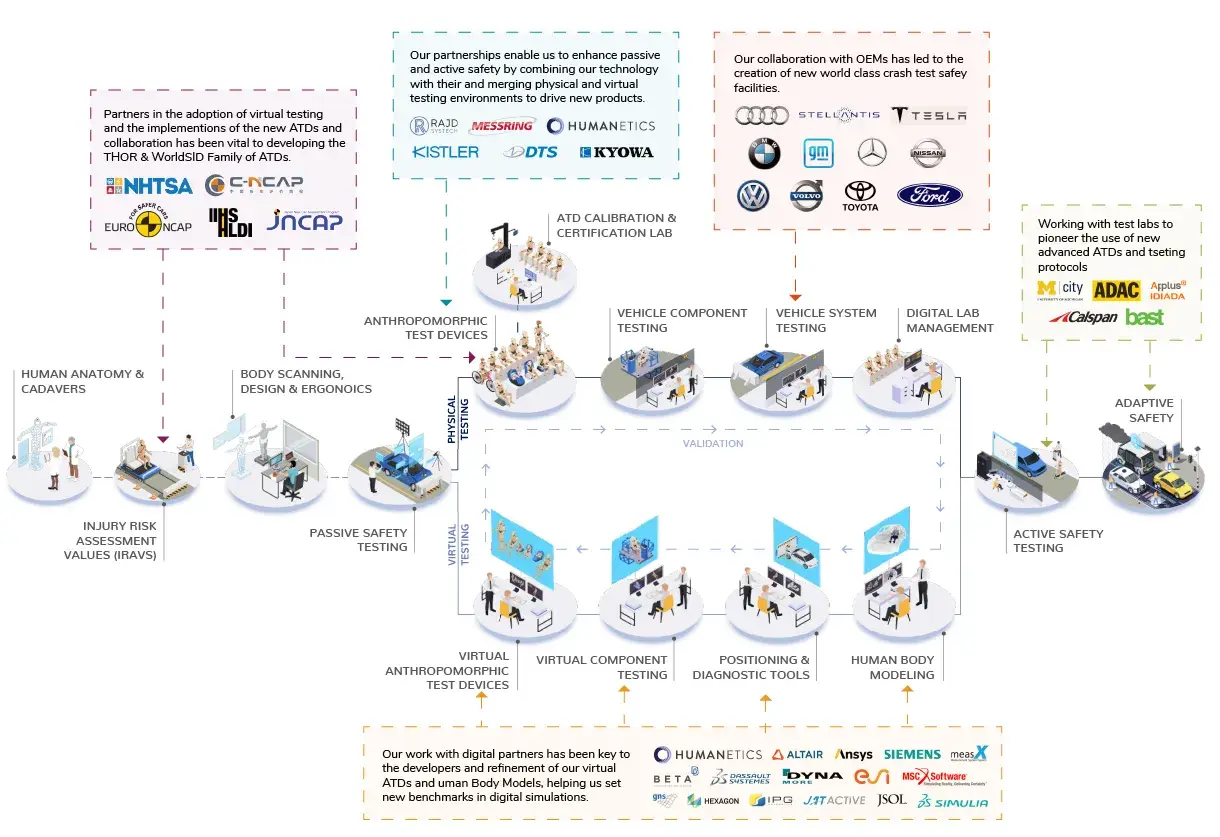
The Agile Model of Development provides the structure for these high-impact alliances. It combines the agility of startups with the scale of industry leaders, creating environments where trust, speed, and continuous learning define the norm. Projects under this model achieve a 64% success rate, far outpacing traditional approaches.
By convening manufacturers, suppliers, research groups, and regulators, it builds industry-wide consensus on safety features and test protocols. This level of cooperation accelerates the adoption of new technology and ensures every stakeholder has a seat at the table.

As Humanetics CEO Christopher O’Connor puts it, “True innovation happens when industry leaders, researchers, and technology experts come together every step of the way.” The imperative is clear. Road fatalities are rising. The time to act is now. The future belongs to those who collaborate boldly, adapt quickly, and never stop learning.
The Time to Lead Is Now
The message is clear: waiting is no longer an option. Regulatory pressures are intensifying, consumer demands are evolving, and the cost of inaction, through reputational damage or product failure, is only rising.
Our 8-part series laid out the foundation for change: inclusive design, agile collaboration, and fully integrated ecosystems. But that foundation is only the beginning. It is now the responsibility of leadership to embed safety into every layer of product development, across every function and partner.
The Agile Partnership Model is not just a framework. It is the mechanism for rapid innovation, system-level integration, and industry-wide transformation. For leadership, the directive is simple: lead with bold collaboration, move with speed, and commit to continuous learning.
If safety is not your mission, it is your liability. The future belongs to those who act—together, and without delay.
Want to Read More?
Subscribe to the Humanetics Pulse newsletter to learn more about safety as a mission and the full ecosystem.
Our 'Safety as a Mission' article series covers several key topics in advancing safety technology to save lives. Click the articles below to continue reading about 'Safety as a Mission:
- Part 1: Embracing the Integrated Ecosystem
- Part 2: Our Shared Mission is to Prevent Millions from Dying
- Part 3: A Vision Inspires Hope. A Mission Demands Action
- Part 4: Equitable Design: Design for Every Body
- Part 5: Pedestrians Take a Hit
- Part 6: Next Generation ATDs & the Connected Lab
- Part 7: Welcome to the Proving Grounds: Smart Testing for Crash Prevention
- Part 8: Partnership as an Accelerator: The Agile Model of Development
- Part 9: Conclusion: Safety as a Mission: The Need for Action.

Barney Loehnis
Barney is the President of Humanetics Sensors & Chief Marketing Officer, leading our Sensor group and marketing growth programs, strategic communications, and customer experience design. He has led marketing and digital transformations in Europe, Asia and the USA in B2B, B2C and agency sectors, for clients like IBM, VW, Huawei, Qualcomm and Mercer Consulting. Barney is a British and American citizen, a bad runner and avid cook.